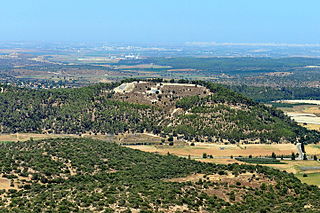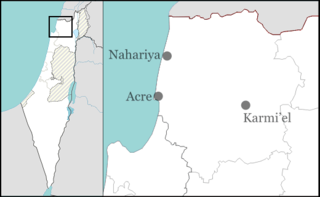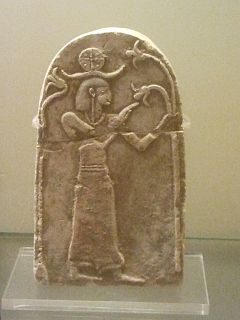Related Research Articles

Bethel is the name of a place often used in the Hebrew Bible. It is first mentioned in Genesis 12:8 as being near where Abram pitched his tent. Later in Genesis, it is the location where Jacob dreamt of seeing angels and God, and which he therefore named Bethel, "House of God." The name is further used for a border city located between the territory of the Israelite tribe of Benjamin and that of the tribe of Ephraim, which first belonged to the Benjaminites and was later conquered by the Ephraimites.

William Foxwell Albright was an American archaeologist, biblical scholar, philologist, and expert on ceramics.

Ono was a biblical town of Benjamin in the "plain of Ono". The modern Kiryat Ono is not to be confused with the biblical Ono. The biblical town of Ono (1 Chronicles 8:12; Nehemiah 6:2) has been identified by most scholars with the Palestinian village, Kafr 'Ana, whereon is now built Or Yehuda, or, more specifically, with the nearby ruin of Kafr Juna, as Kafr 'Ana actually represents a Byzantine-period expansion of a nearby and much older site –– Kafr Juna, believed to be the ancient Ono. The territory of Benjamin was known to stretch from a place around Jerusalem to the plains on the west. According to the Mishnah, the town of Ono was encompassed by a wall before the Israelite conquest of Canaan under Joshua.

Nob was a priestly town in ancient Israel in the vicinity of Jerusalem. The site is largely identified by historical geographers as Bayt Nuba. It likely belonged to the Tribe of Benjamin, Jerusalem being at the border between the tribes of Benjamin and Judah.
Gibeah is the name of three places mentioned in the Hebrew Bible, in the tribes of Benjamin, Judah, and Ephraim respectively. The location in Benjamin is best-known, and generally identified with Tell el-Fūl in northern Jerusalem.

Kiriath-Jearim was a city in the Land of Israel. It is mentioned 18 times in the Hebrew Bible. The biblical place was identified with Abu Ghosh.

Azekah, also known as Tell Zakariya, was a town in the Shephelah guarding the upper reaches of the Valley of Elah, about 26 km (16 mi) northwest of Hebron. The current tell (ruin) by that name has been identified with the biblical Azekah, dating back to the Canaanite period. Today, the site lies on the purlieu of Britannia Park. According to Epiphanius of Salamis, the name meant "white" in the Canaanite tongue. The tell is pear shaped with the tip pointing northward. Due to its location in the Elah Valley it functioned as one of the main Judahite border cities, sitting on the boundary between the lower and higher Shephelah. Although listed in Joshua 15:35 as being a city in the plain, it is actually partly in the hill country, partly in the plain.

MMST is a word written in Paleo-Hebrew abjad script. It appears exclusively on LMLK seal inscriptions, seen in archaeological findings from the ancient Kingdom of Judah, whose meaning has been the subject of continual controversy.

Timnath or Timnah was a Philistine city in Canaan that is mentioned in the Hebrew Bible in Judges 14 and in connection with Samson. Modern archaeologists identify the ancient site with Tel Batash or Tell Butashi (Arabic), a tell lying on a flat, alluvial plain, located in the Sorek Valley ca. 7 kilometres (4.3 mi) north-west of Beit Shemesh, near moshav Tal Shahar in Israel. The site is not to be confused with the copper-smelting site of Timna in the Arabah near Eilat.

Bi'ina or al-Bi'na is an Arab town in the Northern District of Israel. It is located east of Akko. In 2003, Bi'ina merged with Majd al-Krum and Deir al-Asad to form the city of Shaghur, but was reinstated as a local council in 2008 after Shaghur was dissolved. Bi'ina has a mostly Muslim population (92%) with a small Christian minority (8%); in 2019 its population was 8,381.

Beit Hanina is an Arab Palestinian neighborhood in East Jerusalem. It is on the road to Ramallah, eight kilometers north of central Jerusalem, at an elevation of 780 meters above sea level. Beit Hanina is bordered by Pisgat Ze'ev and Hizma to the east, Ramot, Ramat Shlomo and Shuafat to the south, Beit Iksa and Nabi Samwil to the west, and Bir Nabala, al-Jib, Kafr Aqab and ar-Ram to the north.

Bethany or what is locally known as Al-Eizariya or al-Azariya, is a town in the West Bank. The name al-Eizariya refers to the New Testament figure Lazarus of Bethany, who according to the Gospel of John, was raised from the dead by Jesus. The traditional site of the miracle, the Tomb of Lazarus, in the city is a place of pilgrimage.

Tell es-Safi was a Arab Palestinian village, located on the southern banks of Wadi 'Ajjur, 35 kilometers (22 mi) northwest of Hebron which had its Arab population expelled during the 1948 Arab-Israeli war on orders of Shimon Avidan, commander of the Givati Brigade.

Royal Palace at Tell el-ful is an abandoned structure near Beit Hanina, atop a hill known as Tell el-Ful.

The Road of the Patriarchs or Way of the Patriarchs, is an ancient north south route traversing the land of Israel. The name is used by biblical scholars because of mentions in biblical narratives that it was frequently travelled by Abraham, Isaac and Jacob.

The Tower of Hananeel is a tower in the walls of Jerusalem, adjoining the Tower of Meah to the east connecting to the "sheep gate". It is mentioned in Nehemiah 3:1; 12:39. It is located on the northern wall section of the old city, near the northeastern corner, a point of the city always requiring special fortification and later the sites successively of the Hasmonean Baris and of the Antonia Fortress.

Tell Beit Mirsim is an archaeological site in Israel, on the border between the Shfela and Mount Hebron.
Beth-Anath was mentioned in the Bible Book of Joshua and the Book of Judges as a land given to Naphtali.
The Book of Joshua lists almost 400 ancient Levantine city names which refer to over 300 distinct locations in Israel, the West Bank, Jordan, Lebanon and Syria. Each of those cities, with minor exceptions is placed in one of the 12 regions, according to the tribes of Israel and in most cases additional details like neighbouring towns or geographical landmarks are provided. It has been serving as one of the primary sources for identifying and locating a number of Middle Bronze to Iron Age Levantine cities mentioned in ancient Egyptian and Canaanite documents, most notably in the Amarna correspondence.
References
- ↑ David Noel Freedman (2000). Eerdmans Dictionary of the Bible. W.B. Eerdmans. p. 560. ISBN 978-0-8028-2400-4.
- ↑ Nehemiah 11:32
- ↑ Guérin, 1868, p. 394
- ↑ About Beit Hanina Archived February 23, 2009, at the Wayback Machine Official Website Beit Hanina Community Center; Mohamed Shaker Sifadden
- ↑ W. F. Albright (1922–1923). "Excavations and Results at Tell El-Fûl (Gibeah of Saul) by the Director of the School in Jerusalem". American Schools of Oriental Research, Annual. 4. pp. 158–160.
- ↑ G. Barkay, A. Fantalkin and O. Tal (2002). "A Late Iron Age Fortress North of Jerusalem". Bulletin of the American Schools of Oriental Research. 328 (328): 49–71. doi:10.2307/1357779. JSTOR 1357779. S2CID 162209614.
- ↑ Boaz Zissu (2012). "Excavations near Nahmanides Cave in Jerusalem and the Question of the Identification of Biblical Nob". Israel Exploration Journal. 62 (1): 54–70.